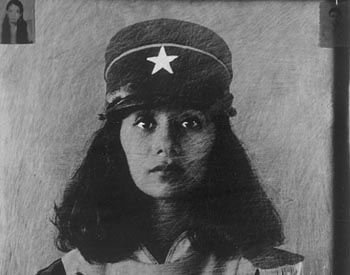Suggestive Whispers
MACLA's 'Transit of Time' show delves into realms of poetic paradox
By Ann Elliott Sherman
THERE'S NOTHING worse than going to see an art show only to be accosted by a curator's explanation of the works' meaning and significance plastered on the adjacent wall in 48-point type. An encounter with art is like a blind date. Before it can end in a soul-wrenching embrace, the matchmaker's gotta get out of the way.
Far from killing the moment before it's begun, MACLA/San José Center for Latino Art instead sets the mood for its new two-person exhibition, Adivinando Los Cursos del Tiempo/Guessing the Transit of Time, by simply posing a few select questions.
Asking "Can works of art be excruciatingly beautiful?" risks a cynical "Ouch," but the show provokes a less jaded affirmative. Printmaker Claudia Bernardi and photographer Luis Gonzalez Palma delve deeply enough into the realms of poetic paradox that the open-ended questions work like suggestive whispers rather than bad pickup lines.
Bernardi has developed an innovative process of applying layers of pure, dry pigments to water-soaked paper and running the sheets through the press to yield what she calls "frescoes on paper." The procedural inverse of Bernardi's labors as a member of the Argentine Forensic Anthropology Team to unearth victims of political violence, the technique produces luminous works in which colors nearly embody spiritual essence. By sifting through hazy, recurrent dream imagery, she revisits nightmarish death and transforms it into an homage to life.
Down one deep-blue edge of the print Maquinaria de Coincidencias/Machinery of Coincidences, birds take wing, half the flock swooping to roost or feast on human skeletons. Although a golden angelic face hovers over the print's center, the viewer's eye ricochets between the fiery orange glow far below and its echo in the cheeks of an outlined female etched into terra-cotta pigment.
This woman has no arms; bare shin bones connect her thighs and feet; a scar runs between her breasts, another from navel down. The earthy hue gives way to another blue vertical border, where a barely visible face floats beneath the brushed intimation of sunlight.
The image of the hewn woman reappears throughout Bernardi's work. Outstretching a hand at the end of a bony, clean-carved arm here, turning to look at an eyeless central figure there, the woman becomes a familiar, strangely settling presence. She is a constant within variations of a bad dream--almost a spirit guide between life and death.
Bernardi dips into more clear-cut narrative with her interpretation of El Vuelo/The Flight, the confession of an Argentine "Dirty Warrior" that describes the practice of stripping unconscious prisoners naked, then throwing them, one by one, out of an airplane.
Throughout all her work, Bernardi bears witness to the horrors of institutionalized killing. Its presence is implied in the scars and bared bones of its victims. Avoiding a caricature of evil in favor of a nebulous underworld defined by glimpses of evil's handiwork means the viewer can't intellectualize the facts in solely political terms. Instead, we must navigate the uncertain terrain where the physical and spiritual worlds collide.
LUIS GONZALEZ PALMA IS fascinated by Joel Peter Witkin's costumed photographic tableaux, the Starn brothers' "distressing" techniques (used to create pseudo antiques out of photographs) and indigenous Mayan culture.
Palma melds these influences in sepia-toned silver-gelatin prints of Guatemalan Indians wearing fantasy costumes or props that are given the stain of age by brushing on watered-down tar. The brush strokes over the face of the stunning unicorn girl resting on a bier in Muerte de Los Sueños/The Death of My Dreams seem to enveil her.
The subjects typically gaze straight into the camera, and Palma intensifies their penetrating effect, their glistening tears, by leaving the eyes untouched by the brown tint. If he is searching the great mirror of history in a people's eyes, he is also clothing them in the vestiges of projected colonial culture and his own dreams. The shoulder-draped robe and metallic cardboard crown of El Rey/The King might have stepped out of a church pageant, but the man's serious, calm dignity makes a mockery out of his trappings, not vice versa.
Transparencies lettered with snippets of poetic text are layered over the photo of a lovely young woman in Pierrot clown clothes in Erase Una Vez/Once Upon a Time. Deciphering statements like "It is true that it is singing" is not nearly as compelling as trying to decide if the woman is dispassionate, contemptuous or sad--it changes, depending upon which eye you focus on.
Below the formality of the poses, beneath the symbols of religious dogma and ritual, it is the secret self, both individual and collective, that Palma seeks to reveal. He often tears, scores and otherwise defaces his photographs, conjuring up the authority of memory as well as its ultimate worthlessness when seeking the truth.
[ San Jose | Metroactive Central | Archives ]
Copyright © Metro Publishing Inc. Maintained by Boulevards New Media.
![]()

Perdida en su Olvido: Luis Gonzales Palma's prints delve into the realms of poetric paradox.
Adivinando Los Cursos del Tiempo/Guessing the Transit of Time runs through June 27 at MACLA/San José Center for Latino Arts, 510 S. First St. (408/998-ARTE).
From the June 4-10, 1998 issue of Metro.
![[Metroactive Arts]](/arts/gifs/art468.gif)